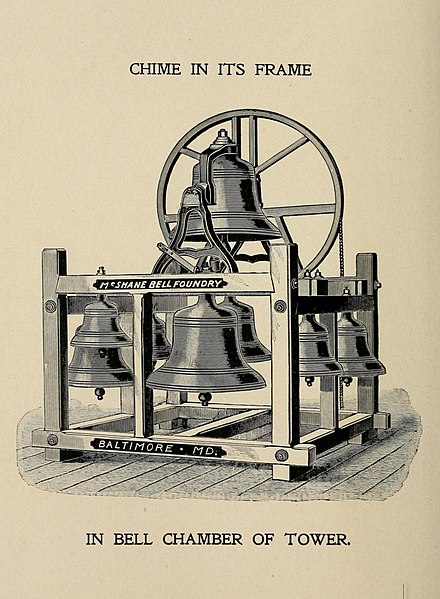A chime or set of chimes is a carillon-like instrument, i.e. a pitched percussion instrument consisting of 22 or fewer bells. Chimes are primarily played with a keyboard, but can also be played with an Ellacombe apparatus. Chimes are often automated, in the past with mechanical drums connected to clocks and in the present with electronic action. Bellfounders often did not attempt to tune chime bells to the same precision as carillon bells. Chimes are defined as specifically having fewer than 23 bells to distinguish them from the carillon. American chimes usually have one to one and a half diatonic octaves. According to a recent count, there are over 1,300 existing chimes throughout the world. Almost all are in the Netherlands and the United States, with most of the remainder in Western European countries.
Eight-bell chime in its frame (McShane Bell Foundry, Maryland). Note that the bottom bells are static-chimes, and the top bell is also hung for swing-chiming on its own.
A carillon ( KARR-ə-lon, kə-RIL-yən) is a pitched percussion instrument that is played with a keyboard and consists of at least 23 bells. The bells are cast in bronze, hung in fixed suspension, and tuned in chromatic order so that they can be sounded harmoniously together. They are struck with clappers connected to a keyboard of wooden batons played with the hands and pedals played with the feet. Often housed in bell towers, carillons are usually owned by churches, universities, or municipalities. They can include an automatic system through which the time is announced and simple tunes are played throughout the day.
A carillonneur plays the 56-bell carillon of the Plummer Building, Rochester, Minnesota, US
The 56-bell carillon of Saint Joseph's Oratory, Montreal, Quebec, Canada
Console of the carillon at the Church of the Sacred Heart of Cholet [fr] in Maine-et-Loire, France
View of the bells and transmission system of the 49-bell Aarschot Peace Carillon [nl] in Belgium




![Console of the carillon at the Church of the Sacred Heart of Cholet [fr] in Maine-et-Loire, France](https://upload.wikimedia.org/wikipedia/commons/thumb/d/d8/Clavier_du_carillon.jpg/640px-Clavier_du_carillon.jpg)
![View of the bells and transmission system of the 49-bell Aarschot Peace Carillon [nl] in Belgium](https://upload.wikimedia.org/wikipedia/commons/thumb/a/a8/Vredesbeiaard_aarschot.jpg/640px-Vredesbeiaard_aarschot.jpg)